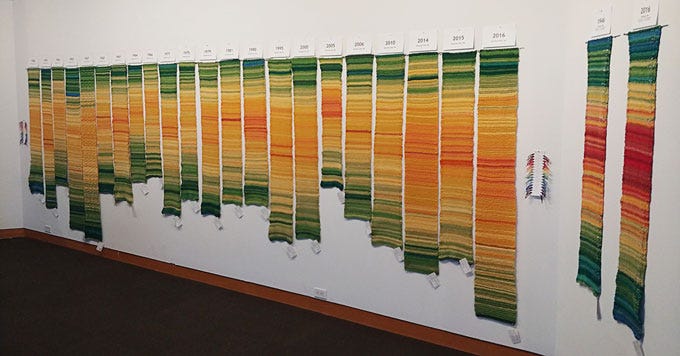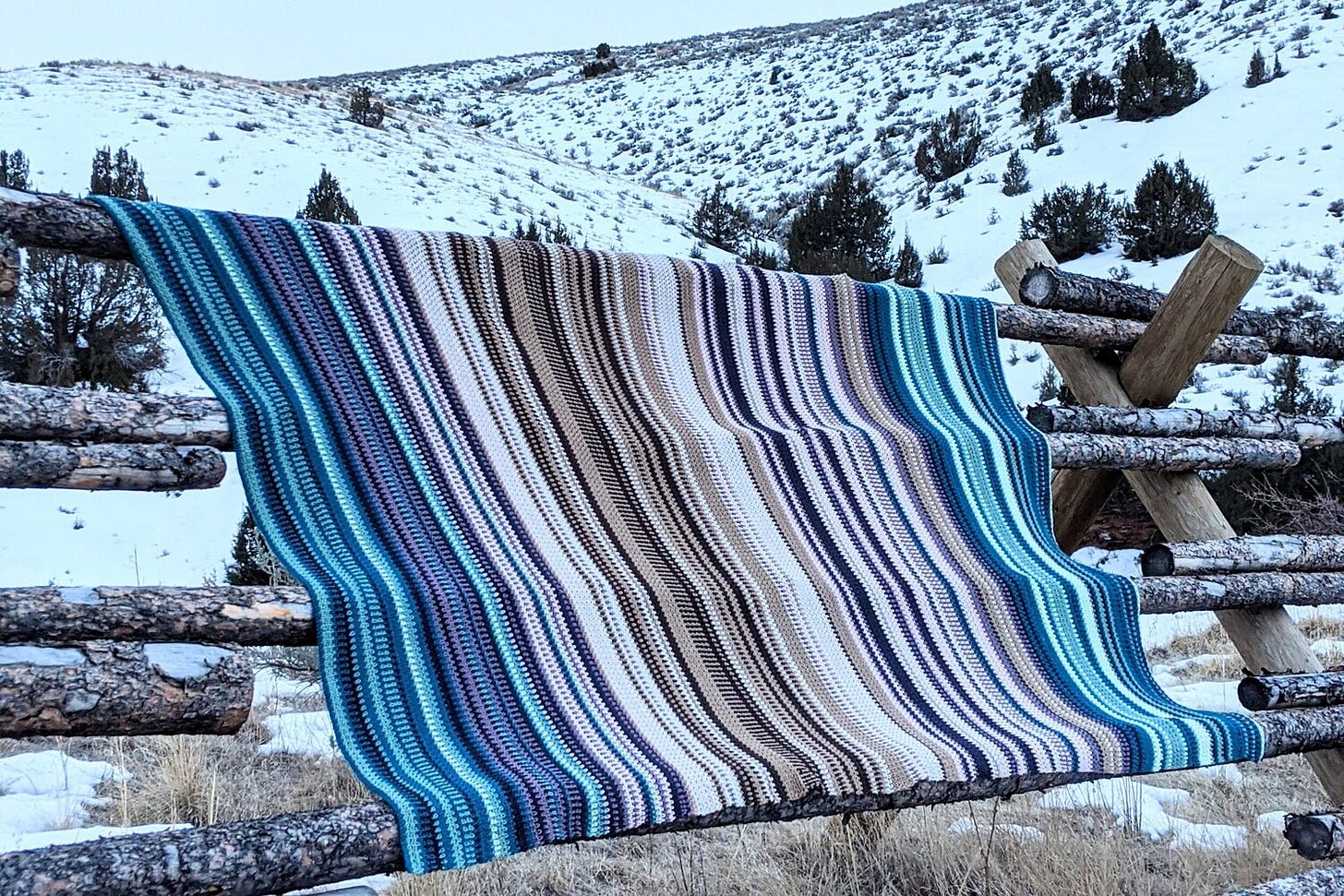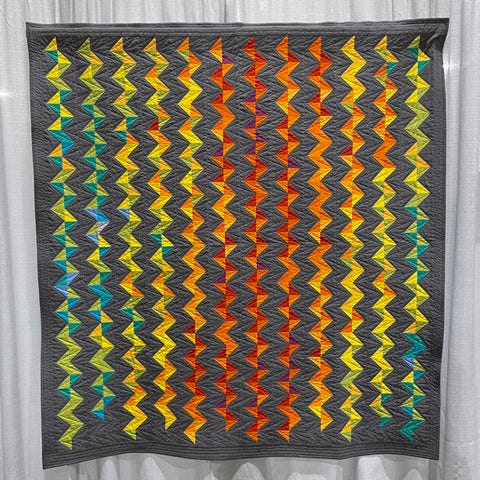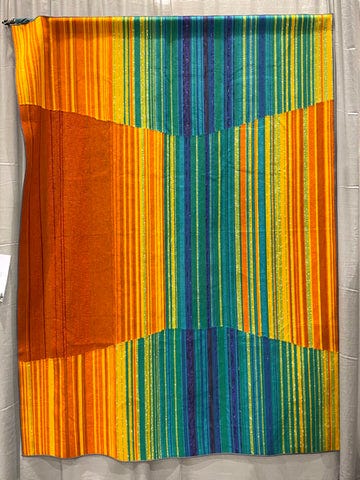#39: The Spinnin' Wheel
First post for 2023: Another foray into citizen science that will keep you warm at night.
Precipitation outside of a cozy indoor nook pairs so nicely with coffee, doesn’t it? Yesterday morning, as I sipped my second morning cup of joe, the constant percussion of rain soothed in a way that snow just cannot.
Yet as lovely as the steady rhythm was this morning, it occurs to me that it’s also a problem.
Because it’s January, not June.
When I was young, Christmas vacation in the eastern part of Canada was snow forts and sledding. Now, it’s more usual to need a slicker and umbrella in the winter, rather than a parka and mittens. And that’s a problem.
While I’m not an expert in climate science, it’s these kinds of moments that give me pause to consider the drastic changes we are witnessing in real time to our climate. Such cases also tie into a project I’ve been considering as of late - the act of citizen science and activism known as tempestry.
Tempestries blend fiber art with temperature data to create a bridge between global climate and our own personal experiences through knitted, crocheted, and woven temperature tapestries…
The Tempestry Project

Tempestry is a representation of data in textile form of your local climate over a set time period, usually created by knitting, crocheting or quilting. It creates a way for non-scientists to raise awareness of the increasing burden of climate change. You, and others, can easily see and interpret the changes in colour over time, without a need for scientific literacy. The mindfulness imbued in the creation of each stitch will hopefully spur action and change in our own habits and consumption.
One of the ongoing problems inherent in discussions about climate change is the vast scale of the conversation. The Tempestry Project’s goal is to scale this down into something that is accurate, tangible, relatable, and beautiful.
The Tempestry Project
I’ve been considering such a project for a while. For a bit, I brainstormed alternate ways of creating temperature-related crafts; for example:
Pixels: A coloured square in a journal; a sticky note per day on a blank wall as a paper-based installation;
Jewelry: A beaded necklace; a friendship bracelet à la summer camp.
However, I’ve decided to keep this first attempt simple. I crochet, and enjoy it in the winter months especially as something to do with my hands while I listen to audiobooks or podcasts, or watch a show.
Before I get started, there’s a few matters to consider.
Pick Your Measurement Scale (i.e., the vertical, or y-axis)
You choose how you’re going to divide temperature - usually steps of 10 degrees - and then you assign colours to them. Warmer colours on the wheel for the hotter days, and vice versa. While rainbows were initially common, I’ve also seen examples of alternate colour palettes to better suit a room in your house or taste. I’ll probably go that way, and use a palette of blue-greens (teal) to blue-reds (cranberry).

Update (6-Jan-23): The Tempestry Project read this essay and offered a point of clarification on the selection of temperature ranges and colours:
Pick Your Time Scale (i.e., the horizontal, or x-axis)
Depending on the final project size, you may create your data point by the high temperature for each day, or you can also record and average out temperature data by week, month or year. With the latter, some people then pick a larger swath of time to document in stitch. Some projects record the high and the low for a particular time point, showing them as two halves of a square or circle, to create a more complicated design for their final project.
I love this example below by Joan Chao, who uses triangles cut in half to represent the high and low of the day. They then arrange them in a staggered fashion, and to me, it gives the impression of wind chimes swirling in the breeze on a porch.

I’m not going to overcomplicate things, and will stick with the daily high, as recorded at the Saint John Airport by Environment Canada.
Decide on How You Want to Use the Finished Project
Do you want a blanket for a room in your house? A scarf for the chillier days? A wall-hanging? Depending on how you want to share the results of your “data analysis”, you would then decide whether you’ll create a single stitch, row, or block to represent each data point. Once you have decided, then you do that for every data point in the corresponding colour. This is where I’m still undecided. I think it’ll be a blanket, but I might make a scarf, too.
The other example from QuiltCon’s special temperature blanket exhibit is this one by Bridget Vian. It uses bands of cloth for temperature, and also changes colour for the highs and lows, but adds length of daylight hours into the mix, represented by the narrowing of the bands.

As winter came the daylight got shorter, the bands of warmer daylight hours also got pinched, creating the hourglass figure. (She also used her first year of marriage as the time frame, thus why she starts in the summer, rather than on January 1).
Start Recording
The Inspired Wren has a nice template you can buy and download to record the daily high/low temperature, which is helpful if you decide to batch your stitch-making into a couple days/month rather than a daily exercise (as TL Yarn Crafts suggests).
This, I can do right away, using a spreadsheet and the Environment Canada data, so I’m ready whenever I do start.
Whether shown in a gallery or hung at home, finished tempestries invite conversations about climate change.
Emily McNeil (interviewed by Ariel Hansen for Yale Climate Connections)
Unlike other examples of citizen science - where you go out and collect data that you share with scientists to improve monitoring and oversight (e.g., birding) - the scientists already have the data.
Instead, your contribution comes as a vehicle for change. The tempestry becomes a meaningful knowledge translation tool that spreads awareness amongst the creator (you) but also whoever might see the piece.
And that’s something we can use more of.





Bryn, this is wonderful! Will you be keeping us posted with your progress? I'd love to see how it develops!
A few years ago a friend of mine created the most gorgeous crocheted temperature blanket - it was breathtaking. In fact, as a result of her project I started crocheting myself - only granny squares, and only once I'd found a YouTube video by a left-hander that I could follow - and really enjoyed it! Sadly - and again, it's my all-or-nothing-approach to everything that was my downfall - I would crochet for hours every evening until my fingers became so tight that I became discouraged and put my hook away. Maybe I'll take it up again - and this time with a more circumspect approach!
This is so neat! I can knit, but only one color at a time , into one shape 😂